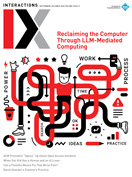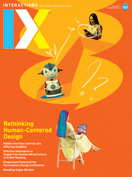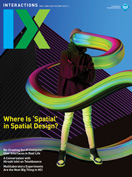Authors:
Yannis Ioannidis
ACM will transition to a fully open access (OA) publishing model starting in January 2026, expanding access to computing research worldwide. Contributors and readers of Interactions have asked what this change means for them and how it will affect our publishing process. Elizabeth F. Churchill and Mikael Wiberg, the magazine's editors in chief, in collaboration with SIGCHI's president, Neha Kumar, invited ACM's president, Yannis Ioannidis, to address these questions. The goal is to gain a deeper understanding of this significant milestone and to ensure that the HCI community is prepared for its implementation.
What is open access?
Open access is a policy that allows readers to access content without paywalls. It is a cornerstone of open science, a philosophy that reshapes how research should be conducted across all stages of the scientific process. In ACM's case, OA means accessing the publications and related research artifacts, such as software, data, and slides, stored in the ACM digital library, without needing a subscription. It was driven by the emergence of the Web and the rise of institutional and thematic repositories, which allowed authors to self-archive their papers. Its core principles were formalized by the Budapest Open Access Initiative (http://bit.ly/4mqVvMq) in 2002. It was further strengthened in the Bethesda Statement on Open Access Publishing (http://bit.ly/4lZUf34) and the Berlin Declaration on Open Access to Knowledge in the Sciences and Humanities in 2003 (http://bit.ly/4m1q9wl). There are different OA models, generally referred to as green, gold, and diamond.
The ACM open access policy and model signify a major shift toward greater accessibility of computing research, with significant positive implications for the HCI field as well.
Why should it matter to ACM members and others engaging in its activities?
Due to the ACM community's efforts, the organization essentially gave green OA to the conference proceedings in the ACM digital library in the mid 2010s, using instruments such as OpenTOC and Author-Izer, which allowed conference organizers and authors to provide access to their papers at no charge. Since then, ACM has been on the path toward gold OA, where a paper's definitive version of record is offered openly, with relevant costs, namely article processing charges (APCs), paid at publishing time by the authors of every paper. Several communities within ACM, however, have been covering the costs by using their conference income and reserves, with SIGPLAN leading the way. ACM Council made a historic decision in June 2020 that all ACM publications and related research artifacts in the digital library—including all journals, magazines, and conference papers—will be fully open access starting Jan. 1, 2026. This decision democratizes access to the knowledge entrusted to ACM by the research community. Additionally, open access allows authors to have a far wider reach. ACM's data shows that OA articles are downloaded two to three times more and cited 70 percent more than paywalled articles.
What will change for authors of magazines such as Interactions?
During the first year of open access, magazine authors will not be required to pay APCs. ACM will subsidize these costs. (It's important to note that APCs are required only for certain types of content, such as research articles. Other types of content, such as opinion pieces, are not subject to APCs.) Members of the Interactions community should still continue to encourage their institutions (including university libraries, academic departments, and college leadership) to join ACM Open if they haven't already. As mentioned earlier, open access will result in a number of benefits for ACM authors. Several studies conducted over the past 20 years show that OA leads to increased visibility and number of citations, higher research (and possibly societal) impact, and greater ability to achieve reproducibility, transparency, and trust.
When it comes to journals and conference proceedings, in ACM's OA model, institutions, institution clusters, and even countries pay a yearly fee based on the intensity of their recent publication activities. All papers whose corresponding author is affiliated with an ACM OA participating institution are published openly, at no cost to the authors. For other papers, APCs must be paid. Currently, more than 2,700 publishing institutions have joined ACM Open.
What, if any, are the risks for ACM as it moves to open access?
Concerns have been expressed on a couple of fronts: the inability of institutions to join ACM Open due to lack of funds and authors' inability to pay APCs for papers that aren't covered by ACM Open (for example, authors affiliated with non-member institutions, unaffiliated authors, and industry authors). These concerns are especially important, given potential research budget cuts in certain regions with high publishing outputs. ACM has taken significant measures to address these concerns and minimize their impact. The regular APCs are among the lowest charged by any publisher operating a comprehensive, integrated knowledge graph, such as the one maintained by the ACM digital library. Furthermore, to ease onboarding to the OA publishing model, ACM has established a transition plan. For those not covered by ACM Open, APCs will be drastically reduced during the first year and will increase gradually. Additionally, ACM will subsidize APCs for invited authors and those provably unable to cover the publishing costs (for example, due to personal circumstances or coming from certain underprivileged regions of the world). ACM has decided to invest part of its reserves to cover any deficit it may experience due to its new OA policy.
Yannis, what are your final thoughts on OA and what actions can we, as the HCI/UX community, take to support this change?
Open access (to publicly funded research) is an obligation that we, the scientific community, owe to society to (re)establish its trust. The foundations of OA and their principled implementation will hopefully lead us back to the roots of scholarly communication, bringing back scientific publishing to the scholarly societies, such as ACM, academies, and academic institutions. The ACM open access policy and model signify a major shift toward greater accessibility of computing research, with significant positive implications for the HCI field as well. ACM is grateful to the HCI community for its support of our open policies through the years. HCI researchers should stay informed about their institutions' ACM open status and understand the options available for publishing their work. While the transition may require adjustments in funding models for some, the increased visibility, impact, and democratization of knowledge promise to significantly benefit the HCI community. Borrowing (with permission) OpenAIRE's slogan, let me make this my last thought on the ACM open access policy and model: "Science! Set free!"
Yannis Ioannidis is the president of ACM. He is a professor in the Department of Informatics and Telecommunications at the National and Kapodistrian University of Athens.
Copyright 2025 held by owner/author
The Digital Library is published by the Association for Computing Machinery. Copyright © 2025 ACM, Inc.







Post Comment
No Comments Found